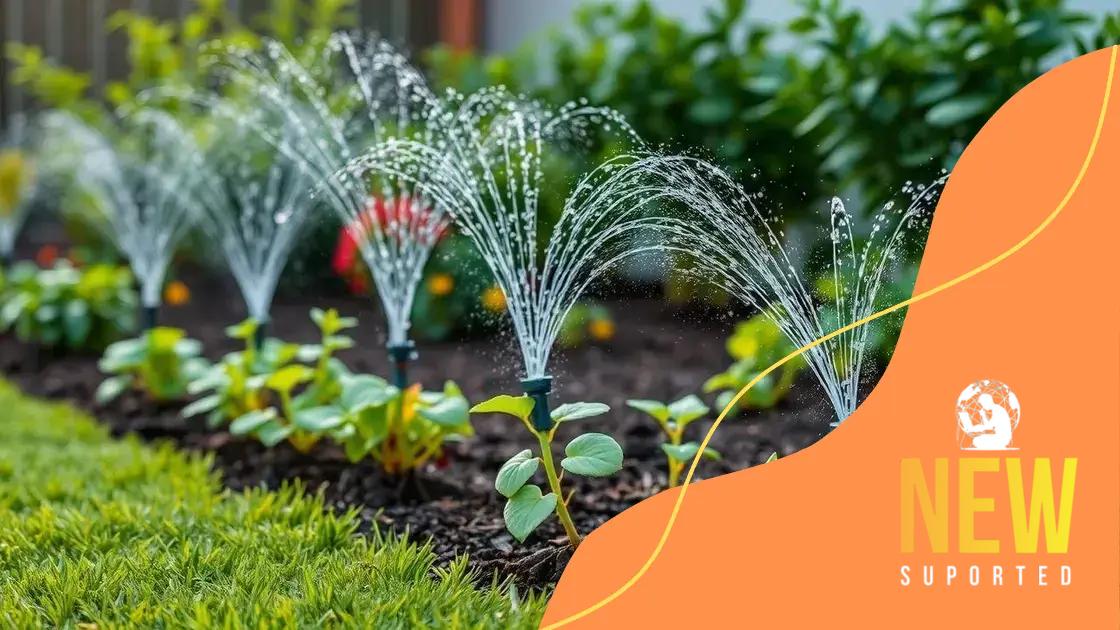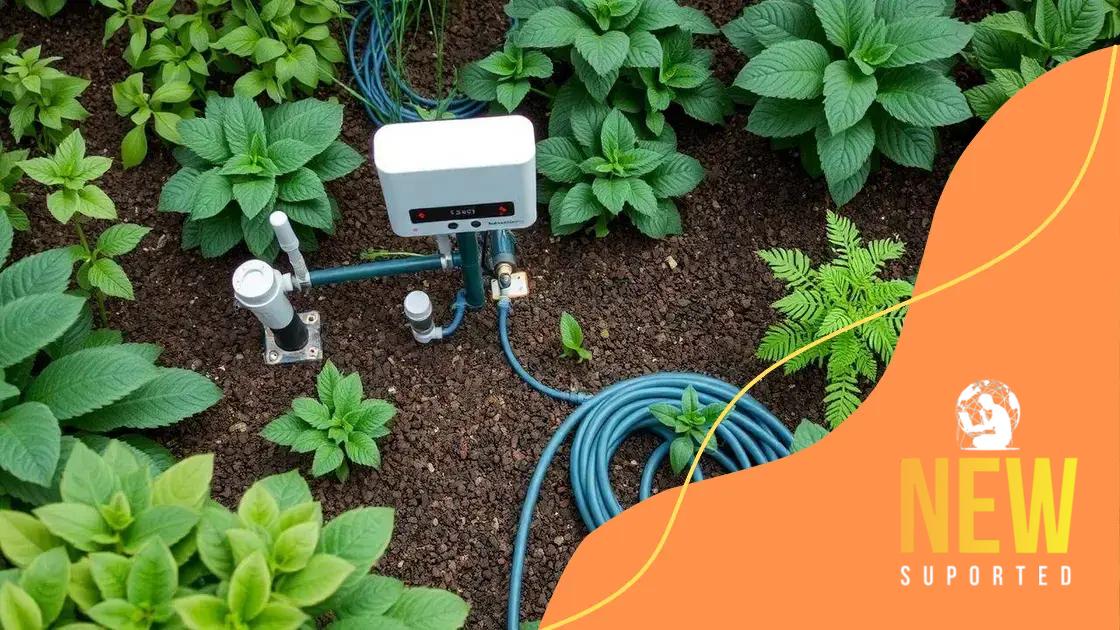The rise of smart irrigation systems in gardens

Smart irrigation systems automate plant watering using sensors and data analytics, enabling efficient water usage and healthier gardens while adapting to real-time environmental conditions.
The rise of smart irrigation systems in gardens is changing the way we approach garden care. Imagine watering your plants effortlessly, while saving water and energy. Let’s dive into how these systems work and what they can do for your green space.
Understanding smart irrigation systems
Understanding smart irrigation systems is essential for modern gardening. These systems utilize technology to optimize how we water our plants and can drastically improve water efficiency.
Smart irrigation systems rely on sensors to determine when and how much water is needed. This way, they prevent overwatering and ensure that plants receive the right amount of moisture.
Key Components of Smart Irrigation
There are several vital parts of these systems that work together:
- Sensors: Measure soil moisture and environmental conditions.
- Controllers: Automate the watering schedule based on sensor data.
- Emitters: Deliver water directly to the plant roots, minimizing waste.
- Weather data integration: Adjusts watering schedules based on rainfall forecasts.
For example, a moisture sensor might signal the controller to turn off watering when it has rained, which conserves water. This kind of efficiency directly benefits the environment and saves on water bills.
Advantages of Smart Irrigation
Using smart irrigation systems offers many benefits:
- Water conservation: Reduces overall water usage.
- Time savings: Automates the watering process, freeing up your time.
- Healthier plants: Provides optimal moisture levels for plant growth.
- Cost savings: Lowers water bills in the long run.
When you invest in a smart irrigation system, you’re not just improving your garden; you’re helping the planet. You’ll notice that plants thrive more when they receive the right amount of water consistently.
In conclusion, understanding smart irrigation systems can transform how you manage your garden. By incorporating these systems, you ensure a greener, healthier environment for your plants.
Benefits of smart irrigation technology
The benefits of smart irrigation technology are significant, transforming how we manage gardens and landscapes. By making watering more efficient, these systems support plant health and promote sustainability.
One of the standout advantages of smart irrigation is water conservation. These systems automatically adjust to weather conditions, ensuring that plants are only watered when needed. This capability reduces water waste and can lead to lower utility bills.
Key Advantages of Smart Irrigation
There are several key advantages to consider:
- Increased Efficiency: Smart systems deliver precise amounts of water, reducing overwatering.
- Healthier Plants: Consistent moisture leads to stronger, more vibrant plants.
- Saves Time: Automation means you don’t have to manually water your garden.
- Environmental Impact: Using less water benefits ecosystems and conserves resources.
Imagine a garden where every plant gets the right amount of water without any effort on your part. That’s what smart irrigation can do. The result? A flourishing garden with minimal water usage.
Cost-Effectiveness
Investing in smart irrigation can also save you money over time. Many systems come with features that monitor water usage and provide data, helping you make informed decisions. When you save water, you save on your water bills.
Furthermore, the initial investment in smart irrigation technology often pays off through enhanced plant health and reduced labor costs. Having a lush, green garden without the high maintenance is a dream for many gardeners.
Incorporating smart irrigation technology into your gardening routine can lead to numerous benefits, enhancing both your gardening experience and the health of your plants.
How to set up a smart irrigation system

Setting up a smart irrigation system can be a straightforward process that greatly enhances your garden’s efficiency. With the right steps, you can ensure your plants receive the perfect amount of water.
Before starting, it’s essential to evaluate your garden’s needs. Take into account factors like the types of plants, soil type, and sunlight exposure. This will help you determine the best system for your garden.
Step-by-Step Setup Guide
To help you get started, here’s a simple guide:
- Choose the right system: Research various smart irrigation systems to find one that matches your garden’s needs and budget.
- Gather necessary materials: Ensure you have all components, including sensors, controllers, timers, and hoses.
- Install the sensors: Place moisture sensors in the soil to measure moisture levels accurately. Position them where your plants are most thirsty.
- Connect the controller: Set up the system’s control unit, ensuring it can communicate with your sensors and adjust watering schedules based on their readings.
After installation, calibrate your system for optimal performance. This may involve setting watering times and durations based on the information gathered from your sensors.
Testing Your System
Once everything is installed, testing is crucial. Run the system for a few days to monitor its efficiency. Observe how well your plants are being watered and if there are any dry spots. Adjust as necessary to ensure every plant gets adequate moisture.
In summary, setting up a smart irrigation system can make gardening easier and more efficient. These systems help promote healthy plant growth while conserving water. By following these steps, you can create an automated watering routine that fits your garden’s unique needs.
Choosing the right smart irrigation tools
Choosing the right smart irrigation tools is crucial for maximizing the efficiency of your garden watering. With many options available, it’s essential to consider various factors that suit your specific gardening needs.
First, consider the size of your garden. If you have a small garden, a basic system with fewer components may be sufficient. For larger areas, a more complex system with multiple sensors and zones will be beneficial.
Types of Smart Irrigation Tools
Here are some popular tools to think about when setting up your smart irrigation system:
- Moisture sensors: These devices detect soil moisture levels and send data to the system, allowing for precise watering.
- Smart controllers: They automate the watering schedule based on input from moisture sensors and weather forecasts.
- Drip irrigation systems: Ideal for targeted watering, they direct water straight to the roots, reducing waste.
- Weather stations: These collect weather data and adjust your irrigation system accordingly.
When selecting tools, always check their compatibility. Ensure that the sensors, controllers, and other devices work together seamlessly. This integration allows for better communication between components, optimizing the watering process.
Budget Considerations
Your budget is also an important factor. While smart irrigation tools can save money long-term, it’s smart to compare prices and features. Investing in quality components may have higher upfront costs but can lead to greater savings and efficiency in the long run.
In addition to cost, consider the user interface. Some systems come with mobile apps for easy monitoring and control. This can make managing your garden much simpler, allowing you to adjust settings even when you’re away.
By carefully selecting the right smart irrigation tools, you can ensure that your garden thrives while conserving water and reducing maintenance time.
Future trends in garden irrigation
The future of garden irrigation is exciting, with technology rapidly advancing to enhance how we water our plants. These innovations promise better efficiency, water conservation, and easier management of garden systems.
In the coming years, we can expect more integration of smart technology in irrigation systems. For instance, artificial intelligence (AI) will likely play a significant role in optimizing watering schedules based on real-time weather data and soil moisture levels. This means your garden could receive just the right amount of water whenever it needs it.
Emerging Technologies
Several emerging technologies are shaping the future of garden irrigation:
- Cloud-based management: Gardeners will be able to control their irrigation systems remotely through mobile apps, making adjustments from anywhere.
- Advanced sensors: Next-generation sensors will provide more accurate data on soil conditions and moisture levels, allowing for precise irrigation.
- Rainwater harvesting systems: These systems will become more efficient, helping gardeners collect and use rainwater for irrigation purposes.
- Drones and robotics: Drones may be used for monitoring large gardens and agricultural fields, providing insights on irrigation needs and plant health.
As we embrace these new technologies, sustainability will be a key focus. Using water-saving devices and methods will not only benefit your garden but will also contribute to a greener planet.
Smart Irrigation Systems
The integration of smart irrigation systems will lead to improved resource management. These systems can adapt automatically to weather changes, ensuring plants receive optimal watering without wasting resources. Innovations like weather forecasting integration within smart systems will soon allow for the automatic adjustment of watering schedules based on predicted rainfall.
With these advancements, gardeners will save time and effort. Automated systems reduce the need for manual checks, allowing you to focus on enjoying your garden rather than worrying about its maintenance.
As technology evolves, so will the methods we use to care for our gardens. Keeping an eye on future trends in garden irrigation will help you stay ahead and make informed choices for a more sustainable gardening experience.
In conclusion, adopting smart irrigation systems can greatly enhance your gardening experience. By understanding the technology and choosing the right tools, you can create a sustainable garden that thrives on efficient watering. Future trends like advanced sensors and automation promise even greater efficiency, making it easier to manage your plants while conserving water. Embracing these innovations not only benefits your garden but also contributes to a healthier environment. Now is the perfect time to explore these exciting options and transform your gardening practices!
FAQ – Questions about Smart Irrigation Systems
What is a smart irrigation system?
A smart irrigation system is a technology that automates the watering of gardens using sensors and data analytics to optimize water usage.
How can smart irrigation systems save water?
These systems use moisture sensors to determine when plants need water, preventing overwatering and unnecessary water waste.
Are smart irrigation tools easy to install?
Yes, most smart irrigation tools come with user-friendly instructions and can be installed by anyone with basic gardening knowledge.
What are the future trends in garden irrigation?
Future trends include advanced sensors, AI integration for better scheduling, and mobile app management, making irrigation even more efficient.






